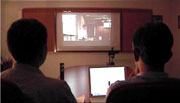IMSC Reaches Internet Milestone with Low-Cost, High-Quality Internet Streaming

Dwipal Desai (l) and Moses Pawar (r)
using the video streaming system

January 30, 2004
The Integrated Media Systems Center (IMSC) at the University of Southern California reached a milestone in Internet application development Thursday with the demonstration of low-cost, live, two-way, high-definition video and two-channel audio streamed over the Internet between the University of Hawaii in Honolulu and an IMSC lab.
"Business teleconferencing can now potentially be much more affordable and flexible over the Internet," according to Prof. Roger Zimmermann, who conducted the demonstration for researchers at a meeting of the Asia-Pacific Advanced Network Consortium in Hawaii.
"In the past, businesses have had to pay the extra cost of dedicated lines among company sites for teleconferencing. But now they will be able to use the Internet for extremely high-quality, low-cost teleconferencing and other applications," he said.
In the demonstration, Prof. Zimmermann introduced the audience in Hawaii to two of his students, Dwipal Desai and Moses Pawar, who were at IMSC's lab. The students then addressed the audience for about 10 minutes, explaining the technical details of the system.
The demonstration used the high-speed capabilities of the Internet, which are developed and used in research by universities and others and are available commercially to businesses in many areas. (The Internet's high-speed capabilities have been developed by several research initiatives, using such names as Internet 2 and the Next Generation Internet.)
Prof. Zimmermann said that most traditional implementations of live media streaming suffer from a number of limitations. For example, he said, the picture resolution and quality are usually limited and do not convey a good sense of presence. He also said that, in the past, the few systems that have achieved HD media quality have required very costly equipment. The equipment for the IMSC system costs less than one-tenth of the cost of the comparable systems.
Prof. Zimmermann's group integrated an MPEG-over-FireWire acquisition module, a low latency transmission protocol, and a high-speed software decoder in the new system.
This live streaming system is a component of the High Performance Data Recording Architecture (HYDRA) project. The goal HYDRA is to improve current applications and enable new ones by acting as an efficient media stream coordinator that manages the transmission, recording and playback of many different data streams simultaneously. Go to http://dmrl.usc.edu/hydra for more information on HYDRA.